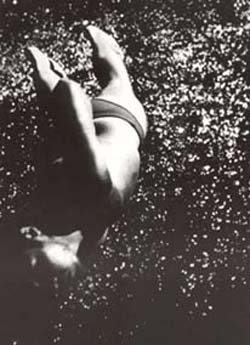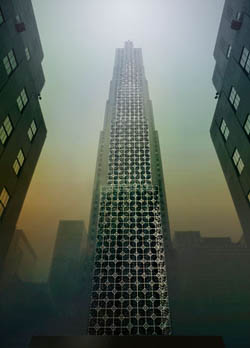Bullets and Bunkers
John Haberin New York City
Chris Burden and Endurance
Who would have thought that Chris Burden would live long enough for a retrospective? The New Museum, however, is prepared for "Extreme Measures."
For Burden, twenty-two days in bed or hours peddling a bicycle around a gallery count as rest and relaxation. He dragged his body over broken glass. He hung naked by his feet before crashing to the floor. He trapped himself for five days in a locker meant for hand baggage, with only a supply of water. He lay out of sight in an upper corner of a gallery. As the song goes, he found himself up on the shelf, and that was that. 
He strapped himself to the floor, close to water crossed by live wires, and held still more current to his chest. He doused his surroundings in gasoline and set it aflame. He lay under a tarp on a highway, not just in danger but as if already dead. He stood for rifle fire and had himself crucified to the hood of a car. Other artists his age are overdue for rediscovery. Burden might be having a resurrection.
He was out to display his endurance. And "Endurance" was also the provocative title for an exhibition eighteen years ago, at Exit Art. It turned out to refer not solely or even primarily to the viewer's sense of tedium. Rather, it showed what Burden and other performance artists once allowed themselves to endure in public. Yet it left one with a remarkable sense of calm and a fresh awareness of one's surroundings. When it comes to art, the most extreme act of all is looking.
Bear with me
Those notorious feats took place between 1971 and 1974, and Chris Burden has moved on from momentary dangers to weighty objects. Born in 1946, the LA artist seems quite happy to have put the past behind him. A scrapbook describes it all, but upstairs in what the New Museum ordinarily calls its education center. In a film about the shooting, Burden is surprisingly dismissive of his own harsh lessons. Speaking to the BBC in 2012, he compares the two bullet wounds ("in and out") to vaccination marks. He did not say that he gave art a shot in the arm.
In its own strange way, this really was a quieter era—a time when the police could lift him off the highway, arrest him for faking an emergency, listen to a cockamamie story blaming someone else, note that he was not pressing charges, and set him free. He can be metaphorically as well as fatally self-effacing, too. Remember John and Yoko in bed for peace? Burden did not require a hotel room and the trappings of celebrity. He survived in that locker and behind a gallery wall rather than, like Marina Abramovic, for all to admire and to see. f he still demands way too much attention to horrors inflicted entirely on himself, he is pleading for the viewer to feel and to see.
Not that anything was ever so benign, like a leap in the dirt for Dennis Oppenheim, not with an artist so determined to put others and not just himself on the spot. Already, he was turning his comic aggression outward, as when he "hijacked" a TV interview by holding a knife to his host's throat. He can sneak back into the spotlight, if modestly, with wall labels in the first person. He can be as blasé about meaning as about consequences, too, as with the crucifixion. (Somehow he missed the outrage accorded Piss Christ and Madonna with elephant turds.) Still, his retrospective is hard to dismiss precisely because it reflects so much unfocused fear, from the nuclear age to race riots to Wall Street.
At least three works make those fears explicit. One consists of cardboard models of every U.S. submarine ever, since 1897, including the Poseidon fleet that once maintained nuclear deterrence. Another papers a wall with police uniforms, fully equipped with badges, batons, and Berrettas. Burden is remembering Rodney King, and he makes the dark uniforms larger than life. Matchstick men guard a "tower of power" of gold bricks—as do real guards, who oblige one to enter singly and to keep one's hands out of one's pockets. I still do not know who imposed the constraints, the artist or the exhibition's insurers.
Still, Burden has changed since the 1970s, as if desperate to give his fears velocity and weight. He appears just once more on film, ranting (in French) about how women and foreigners have created a savage world. More often, he is visible only through objects—and I mean big objects, on every floor of the museum. The iron cube suspended from a crane truck even comes inscribed with its weight, at exactly one ton. The objects also become slicker and shinier, like two "quasi-legal" skyscrapers on the museum's roof. That 1964 Ford truck has new tires, plush seats, and a flatbed of hardwood that a condo would envy.
He has created a teeter-totter from a meteorite and a beautifully restored sports car, which he describes as a "poor man's Porsche." An early installation, a motorcycle that powered a three-ton flywheel in 1979, looks like a rust heap by comparison. Is he moving away from squeamishnesss for its own sake, or has he become just another museum fixture? Has he been exploiting the fears of others all along, or has he recovered an essential connection between art and the viewer? Before answering, take a step back, before today's big-budget installations. A 1995 survey of performance art, including Burden's, supplies context—and also the occasion for one of this site's very first reviews.
Performance appraisals
Art often tries one's patience. Jill Magid, for one, has used pathological fears of insects to explore the legitimacy of torture, and Carlos Martiel has tortured himself as a Cuban in protest against America. As critics have said, performance art can be like listening to someone else's therapy. As in therapy too, however, the risks also fall on the subject—the artist. Endurance cuts both ways. With "Endurance" in 1995, Exit Art supplied just that word.
 In its Soho years, the nonprofit typically squeezed every possible inch out of its large spaces. In another corner it sold refreshments—maybe not the best reason to miss it. Plenty of its shows crossed the line to banality. This one managed the remarkable feat of recasting banality itself. The layout paired photographs, nearly uniform in format, with well-written extended captions. Together, they offered a documentary history of performance art.
In its Soho years, the nonprofit typically squeezed every possible inch out of its large spaces. In another corner it sold refreshments—maybe not the best reason to miss it. Plenty of its shows crossed the line to banality. This one managed the remarkable feat of recasting banality itself. The layout paired photographs, nearly uniform in format, with well-written extended captions. Together, they offered a documentary history of performance art.
From tedium to discomfort, performance has its roots in endurance. The artists' feats started out relatively benign. Yes, John Lennon and Yoko Ono just wanted you guys to bring about world peace—or, in "The Riverbed," your own. Pieces like this go down a lot easier in a few inches of wall space anyhow. Before long, however, "endurance" took on brutal overtones. In wall after wall of black-and-white photos, even long past self-torment came shockingly alive.
To Michelangelo, difficultà meant superhuman skill. In performance, the difficulty could be simply surviving. "Endurance" put the performance back in performance art—even when, as for Burden, the performer could not be viewed. It demonstrated the artist's insistent acting and persistent vulnerability. It also gave the viewer a shared experience of risk. After enough physically intense descriptions, I started to read more quickly, almost for dear life.
These days, one learns to take almost anything in stride. Besides, attention to the body need not mean endangerment, not even for Nayland Blake. For Eva Hesse, it meant danger, but also a woman's daily experience. For Marina Abramovic, it means taking over a museum, as the star attraction. Yet Burden, who dominated the show's second room, invokes danger again and again. He could not yet leave it to education centers and to history.
The numbing sequence of captions communicated well enough the limitations of the art. I cannot claim that I like performance all that much better than before. Yet "Endurance" and Burden have both taught me to appreciate an often tiresome, foolish decade much better, and my renewed appreciation now extends to Minimalism, too. I can now see the art of Richard Serra as, inescapably, about the fragility of bodily experience. Minimalism and performance art, I realized, grew up together—as with Joseph Beuys, Bruce Nauman, or the vast cages of Antony Gormley. Even Carl Andre asks viewers into the work of art, to complete it with the touch of their hands and feet.
Go silently or else
Artists are often right to be controlling. I include even those as insistent as Carl Andre or as downright insane as Burden. Art that makes one think and feel has to make demands. The longer one lives with memories of a single good work, the more demands it makes. From Paul Cézanne to John Cage, Modernism dealt with blank spaces. Minimalism and performance art show how the artist and viewer must work together to fill the silence.
Postmodernism is predicated on the idea that there is never silence. On the one hand, it asserts that, regrettably, life is a buzz of media vibes. On the other hand, it argues positively that neglected political issues must not be allowed to fester in silence. The combination makes much contemporary art impressively outspoken. Artists are now asserting real cultural needs that "fine art" sometimes left unsatisfied. They can be no less dogmatic than the past for all that.
Burden has lived through both times, and they can be a lot to endure. His career now runs from low-budget performance to today's macho installations. His early performances bridge the casual irony of Southern California art for John Baldessari and its deadly implications for Jack Goldstein. With A Tale of Two Cities from 1981, he imagines entire global cities in a state of perpetual war, but he is also just one of the boys with their toys. In his case, that means half a museum floor of toy soldiers and real bullets. He can safely declare a pair of stone cannons of seventeenth-century design "fully functional."
His motorcycle's back wheel needed only brief contact to set the enormous flywheel in motion, and one can almost hear its roar. It also introduced another theme—what Lisa Phillips as curator (with Massimiliano Gioni, Jenny Moore, and Margot Norton) calls "our mechanical and technological imagination." And Burden still looks to old engineering principles, with the arches of a concrete bridge held together solely by gravity. He has been obsessing for over a decade now with model bridges, most often as giant Erector sets. He also sets out the hundred thousand or so parts in a cabinet, in case one has time to build one's own. Some might just as soon shut the drawers, to put away childish things.
Burden keeps one guessing, fearing, admiring, wondering, and cringing, and it is hard to say which emotion wins out. At least he is finally prepared to go on the defensive. Beehive Bunker from 2006 should protect him if not from nuclear winter, at least from bullet wounds. There can still be room in art for silence without exile or cunning. The first step is to listen for it. And then maybe the second step is duck and cover.

Chris Burden ran the New Museum through January 12, 2014, "Endurance" at Exit Art/The First World through April 15, 1995. A related review also compares the quiet, solid geometry of Minimalism to performance.




